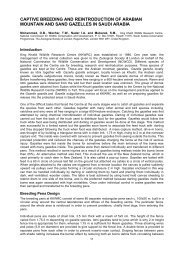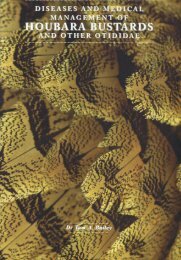His Highness Sheikh Zayed bin Sultan Al Nahyan - Wildlife Middle ...
His Highness Sheikh Zayed bin Sultan Al Nahyan - Wildlife Middle ...
His Highness Sheikh Zayed bin Sultan Al Nahyan - Wildlife Middle ...
You also want an ePaper? Increase the reach of your titles
YUMPU automatically turns print PDFs into web optimized ePapers that Google loves.
3<br />
Status of the Saker in Russia and Eastern Europe<br />
Vladimir M. Galushin<br />
Russian Bird Conservation Union, Moscow<br />
v-galushin@yandex.ru<br />
This review is based on all available publications<br />
as well as internet and personal information provided by<br />
researchers of the Saker in Russia over the last 20 years,<br />
including the majority of authors from the list of references.<br />
Shrinkage of the Saker range<br />
Monitoring of the Saker in Northern Eurasia,<br />
including the most intensive surveys in 1997-2002 run by<br />
the Falcon Research Institute (IWC Ltd) and financed by<br />
NARC and ERWDA (Abu Dhabi, UAE) and other sources,<br />
has shown a clear shrinkage and fragmentation of its range<br />
(Figure. 1). Even in recent handbooks (Hoyo et al, 1994;<br />
Tucker and Heath, 1994; Snow and Perrins, 1998) the Saker<br />
range covers over 3,000,000 km2 of almost the entire<br />
countries of Ukraine, Moldova and southern Russia.<br />
However in these countries it now occupies 2-3x less area<br />
of about 1-1.5 mln. km2 mostly within Asiatic Russia.<br />
In Europe there are 3-5 fragments of the former<br />
Saker range with a few solitary pairs between them. <strong>Al</strong>most<br />
150 pairs nest in Hungary where the Saker population is<br />
growing (in 1980 only 8 pairs were known) thanks to<br />
effective conservation measures, including artificial nests<br />
(Bagyura et al., 1994, 2003; Dudas et al., 2003). In<br />
Slovakia, Bulgaria and some other Balkan countries<br />
probably over 100 pairs live with increasing populations<br />
(Baumgart, 1991, 2000; Tucker and Heath, 1994; Stoyanov<br />
and Kouzmanov, 1998; Fox et al., 2003). Therefore, despite<br />
the high degree of Saker range fragmentation in Southern,<br />
Central and Eastern Europe the population outside Russia<br />
and Ukraine consists of about 250-300 pairs. The<br />
population is relatively stable or even increasing.<br />
In the first half of 20th century the Saker range<br />
covered almost the entire Ukraine, Moldova and Southern<br />
European Russia (Dementiev and Gladkov, 1951; Averin et<br />
al., 1971; Zubarovsky, 1977). However, it shrank rapidly<br />
and at the beginning of 21st century turned into two enclaves<br />
isolated by some 2000 km. One is southern Ukraine<br />
including Crimea (Piluga, 1999; Vetrov, 2001) and probably<br />
Moldova with about 10 pairs at the end of 1980s (Ganya and<br />
Zubkov, 1989; Red Book of Republic of Moldova, 2001).<br />
The other is a south-eastern part of European Russia close<br />
Photo by E. Potapov<br />
to the Southern Ural mountains (Galushin and Moseikin,<br />
1998, 2000; Galushin et al., 2001; Galushin, 2003; Fox et<br />
al., 2003; Karyakin et al., 2004). The last nesting areas<br />
between the Don and Volga rivers were deserted by 1990s.<br />
For example the very last Saker brood was seen about 50<br />
km south of Moscow in 1996 (N.Sanin, pers. comm.). In the<br />
middle of 1990s a nest on a pole of a high voltage powerline<br />
run through agricultural landscape west of the Don river<br />
valley in the Lipetsk region (Sarychev, 1993) was deserted.<br />
At the end of 1990s no sakers have been noted along the<br />
Upper Don river and other areas where falcons had been<br />
numerous in the middle of 20 th century; like the small<br />
“Tul’skie Zaseki” forests about 200 km south-west of<br />
Moscow (Likhachev, 1957; Solovkov et al., 1999), northern<br />
parts of the Orel region (Kharuzin, 1926) and Voronezh<br />
region (Barabash-Nikiforov and Pavlovsky, 1948). One<br />
nesting area at the Volga river bank that had been occupied<br />
by sakers for almost 20 years (Chernobai and Nikitina,<br />
1990) up to 1998 (Lukyanov, 1999) was also deserted in<br />
1999.<br />
The disappearance of the Saker nesting<br />
populations from European Russia is predictable: it had<br />
either already happened at the very beginning of 21 st<br />
century (personal oppinion of V. Moseikin) or would<br />
happen in the coming years.<br />
The Saker breeding range in Asiatic Russia looks<br />
like a relatively large enclave south of the Ural mountains<br />
with a chain of small fragments or isolated nesting areas<br />
along the state border with Kazakhstan up to the most solid<br />
and vast part of the range embraced the <strong>Al</strong>tay-Sayan<br />
mountains and surrounding lowlands near the Baikal lake,<br />
in Khakassia, Krasnoyarsk Kray and Tuva, as well as its<br />
continuation in Mongolia, eastern Kazakhstan and probably<br />
north-western China. Changes in the Siberian part of the<br />
Saker range analyzed recently (Karyakin et al., 2004) were<br />
not so drastic as in Europe.<br />
Decrease of Saker populations in Ukraine and Russia<br />
In the past the quantitative characteristics of the<br />
Saker population trends were uncertain because population<br />
assessment in large areas, including entire countries was<br />
seldom calculated before the 1990s. However, analysis of<br />
local population changes allows us to suppose that in<br />
general they were relatively stable or slightly increasing<br />
during the first half of the 20 th century. They began to<br />
decrease in 1950s – 1960s due to wide-spread use of DDT<br />
and other toxic chemicals, eradication of their principle<br />
food namely sousliks (Citellus spp.) and mass persecution<br />
of raptors. Despite the fact that the anti-raptor campaign<br />
stopped at the end of 1960s (Galushin, 1980) the Saker<br />
population decline continued and even accelerated in 1970s<br />
– 1980s up to an almost total crash in the Ukraine and<br />
European Russia in 1990s.<br />
In southern Ukraine one enclave with about 80<br />
Saker pairs at the beginning of 1990s was known in the<br />
Odessa District (Piluga, 1999). They changed their breeding<br />
habits from raptor’s nests in trees to raven’s nests on<br />
powerline poles (Piluga and Tille, 1991; Kostyushin and<br />
Miroshnichenko, 1995). This population continues to<br />
decline (V.Vetrov, pers. comm.). Another group of Sakers




